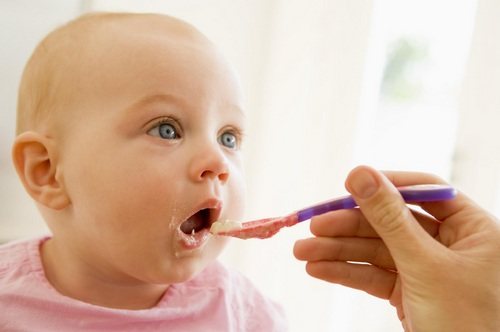Such healthy meat
Only meat contains animal protein, on the basis of which metabolic processes occur; it is one of the main components of the cellular structure of the body, and it is unlikely that it can be replaced with anything else. In addition, meat contains calcium, phosphorus and many vitamins. Due to the fact that meat is a product that is quite difficult for the stomach to digest, it is introduced into the diet of a child under 1 year of age last, first with vegetable purees, and then separately from it as an independent dish. Rabbit, lean beef and pork, chicken and turkey. All this must be purchased from trusted sellers on the market or in a store.
The meat should be fresh and chilled, pale pink in color and appear juicy. For the first feeding, buy a small piece that will not need to be frozen later.
What meat to start complementary feeding with?
- Beef. Rich in protein and iron.
A fairly lean variety of meat. According to price criteria, it is affordable for many families. Of course, it is better to start complementary feeding with it. If a child is allergic, it is better not to start with beef; here rabbit or turkey come to the rescue. - Rabbit, turkey. They are low in calories, low in fat, and practically do not cause allergies. But they have a fairly high cost, up to 400 - 500 rubles per kilogram. But rabbit meat is quite difficult to buy in its natural form.
- Chicken.
If a child is allergic to chicken egg white, then we never start complementary feeding with chicken. It has a fairly low calorie content (in particular, breast), but is no less allergenic. - Pork, as you know, has sufficient fat content and is suitable for babies after one year.
In recent years, allergists have been advising children with allergies to start complementary feeding with pork. - Horsemeat. Rich in protein, but very difficult to find in the market. Suitable for hypoallergenic menus.
- Mutton. Very fatty meat, recommended after 10 months.
- Goose and duck. These meat dishes contain refractory fats that are difficult for a child’s body to digest. For this reason, we exclude goose and duck until they are three years old.
Is it possible to make meat puree yourself?
If you do not trust canned baby food in the store, considering such meat not entirely fresh, you have the opportunity to prepare meat puree for your baby with your own hands.
After purchasing, the meat is thoroughly washed under running cold water, removing veins, fat, skin, and removing bones. After this, cut into small pieces and put in a pan with water, when it boils with the meat, the first time the broth is drained, the meat is again filled with cold water and put on gas.
The cooking fire should be minimal. Time - from 20 to 40 minutes depending on the type of meat. Next, you need to remove the meat and grind it in a blender. After this, the mass should cool, after which part of the meat broth is poured into it. The consistency is chosen according to your desire.
Baby purees are never salted, they do not contain spices and seasonings that you use in your everyday menu.
If you want to mix vegetables and meat, it is better to do it ready-made in a 5/1 ratio, where the majority is vegetable puree.
How to best cook meat for a child
To ensure that the meat retains beneficial substances during cooking, you should follow these tips:
- Thaw the meat the night before. Leave it in the refrigerator on the coldest shelf overnight. Remember, water takes away all the valuables, leaving only fiber in the meat.
- When cooking, place meat only in boiling water. This way the proteins will coagulate faster, releasing and forming a protective film on the surface of the water. It is this that prevents the evaporation of beneficial substances.
- Remove the film, tendons, and fatty layers with a knife in the direction of the fibers. They make the product tougher.
- For juiciness, salt the meat at the end of cooking. It should be soft.
- It should be cooked in one piece.
- If you have an allergy, the meat should be cooked twice. Boil the piece for 20 minutes, then replace the water and cook until tender, about an hour.
- To properly prepare meat for a child - boil, stew, bake in foil, but under no circumstances fry.
- Try to diversify your diet. You can make cutlets, meatballs, soufflés, and purees from meat.
How to introduce meat puree into your diet?

When your baby reaches seven months, you can start feeding your baby with meat puree. The first time the dose can be no more than 1 tsp. on the lunch menu. In order for the body to better absorb meat, it can be added to vegetable puree.
The liver is introduced later, closer to the year. It is better to use chicken liver, since poison can accumulate in this offal, which is useful for humans, over the years, so it is better not to take the liver of such long-lived animals as cows and pigs. Having previously cleared the film, the liver is boiled for about 30 minutes, then rubbed through a fine sieve and mixed with broth in which a small piece of butter is dissolved.
Children love meat very much; they distinguish different varieties by taste, giving preference to some over others. Follow your child’s taste and cook only what you like, because food should not only be healthy, but also enjoyable.
What are the benefits of meat?
- Baby meat is the main source of animal protein. Moreover, plant protein is much inferior to animal protein in its quality characteristics.
- This complementary food is rich in microelements - phosphorus, copper, iodine. Iron from meat dishes is absorbed much better than from vegetable dishes.
- When teeth appear, it is important for a baby to develop chewing skills, so meat is the main assistant in this.
- The high content of vitamins B, PP, and E is also important.
After the first six months of life, the child needs additional microelements and protein. Of course, breast milk contains all of the above nutrients, but as the baby's body grows, it requires more than just milk.
The introduction of meat into complementary foods perfectly complements the diet and covers increased energy costs.
Meat complementary foods are divided into three groups:
- meat based;
- on a meat-and-vegetable basis;
- plant-based with the addition of meat.
The last two groups of complementary foods, as their name implies, include vegetables or cereals in addition to the meat itself. Such additives improve the taste of meat puree and contribute to the diversity of the baby’s diet. In addition, vegetables (due to vitamin C and organic acids contained in them) facilitate the absorption of iron contained in meat.
At what age should meat feeding be introduced?
As for the optimal period for introducing meat complementary foods into a child’s diet, the opinions of experts are divided: some believe that meat can be given starting from 4-6 months; others are convinced that a more favorable period for input is 8-9 months.
According to the Russian national program aimed at optimizing the nutrition of children in the first year of life, meat puree should be introduced from the age of 6-8 months . It is at this age that the baby’s body needs protein and a number of other microelements contained in meat (potassium, iron, magnesium, phosphorus). The timely introduction of meat products into the children's menu contributes not only to enriching the child's body with necessary elements, but also to its harmonious development.
However, the introduction of meat into a child’s diet depends on several other factors:
individual characteristics of the baby’s development; physical development of the baby, indicators of his height and weight; type of feeding (breastfeeding or artificial feeding).
Thus, children who are bottle-fed need earlier introduction of complementary foods, be it juices, fruit, vegetable or meat purees. Breastfed babies receive essential macronutrients through breast milk. Therefore, the introduction of complementary foods for them can be postponed for a couple of months.
Rules for introducing meat into a child’s diet
Meat puree for babies is introduced after vegetable / fruit purees, after juices and cereals.
Before offering meat complementary foods to your baby, it is advisable to familiarize yourself with some rules for first complementary feeding:
Meat (like any other complementary food) should be given only to a healthy child. It is advisable to refrain from introducing complementary foods in the following cases: if the child has been vaccinated or is expected to be vaccinated soon; during the summer heat; if the baby is unwell or capricious. A new product should be introduced no earlier than 2 weeks after introducing the previous product into the child’s diet. The volume of the first complementary food should be 5-10 g (1-2 teaspoons). It is better if the meat puree is added to the vegetable puree the child is already accustomed to. You can also “soften” the meat puree with breast milk or formula. It is gradually necessary to increase the daily dose of complementary foods so that by 9-12 months the child consumes 60-70 g. When using canned products, you need to pay special attention to the composition, make sure that there are no concentrates, GMOs and other substances harmful to the baby. For the first feeding, you should choose a single-component product (rabbit, turkey or chicken are best).
We read in detail about the rules for introducing the first complementary foods (where to start, at how many months).
How to give pureed meat
Baby meat purees should be given warm before breastfeeding or formula feeding. Complementary foods should be offered from a spoon. The child should be in a sitting position.
Meat complementary foods, just like any other, are offered at lunchtime in order to observe the baby’s reaction to the new product during the remaining half of the day.
Meat puree is given to the child once a day.
Complementary meat products
The role of protein in the nutrition of a child from 1 to 3 years old
The menu of a young child must include products of plant and animal origin.
Milk, eggs, fish and meat are animal products that serve as suppliers of amino acids, minerals, vitamins and, of course, protein. Protein is an important building material for a child’s growing body.
If the baby does not receive additional protein, then his appetite decreases, fatigue occurs, and nutritional dystrophy may develop, accompanied by diarrhea and mental disorders. Between the ages of 1 and 3 years, children should receive 4 grams of protein per 1 kilogram of weight.
Making puree at home
Despite the convenience of using canned baby food, preparing meat puree at home is considered more reliable and safe.
To prepare complementary meat, it is recommended to use lean meats (chicken, turkey, rabbit). Small pieces of meat are freed from veins, bones, fat and boiled for 1-1.5 hours. For cooking, you can use a slow cooker or a double boiler. After the meat is ready, it is thoroughly chopped using a blender or meat grinder (it is recommended to scroll 2-3 times). Then the resulting mass is passed through a fine strainer. To obtain puree, breast milk, infant formula, porridge or vegetable puree are added to the ground meat. When cooking meat (as well as directly into meat puree), you do not need to add salt and spices. For each complementary food, only freshly prepared meat should be used.
5 mistakes in introducing complementary foods
Relevance
After a year of life of a newborn child, his diet changes significantly. The child’s teeth grow, the chewing apparatus develops, digestive functions transform and the volume of the stomach increases. The child can remember tastes, distinguish between foods, and a clearer eating schedule is established. At this age, five meals a day are maintained, which is the basis for the development of a constant digestive reflex.
The basis of a balanced diet for a child aged 1 to 3 years is foods that contain animal protein. These products include: dairy products, eggs, fish, poultry, meat.
Up to two years of age, children eat pureed dishes - these can be puree soups, milk porridges or vegetable soups, where vegetables are mashed with a fork.
It is equally important to include meat dishes in the form of cutlets, meatballs, puddings, and casseroles in the diet of children aged 1 to 3 years. However, there is a nuance here - we cook all second courses exclusively by steaming for up to two years. Steamed puddings with various fillings are especially useful.
Nutritionists recommend including sauces made from milk, vegetable broths with the addition of starch and flour in children's diets over the age of one year.
After 2 years of age, foods can already be baked in the oven.











